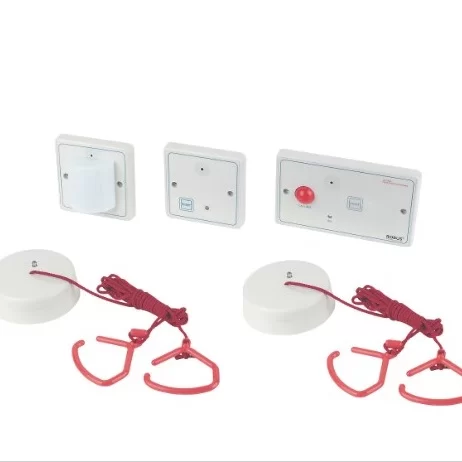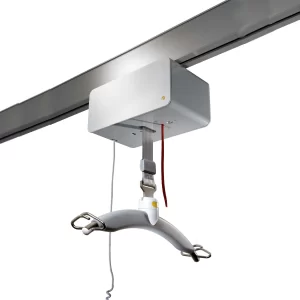Enquire about Changing Places
About The Changing Places Campaign
The Changing Places campaign all began in 2003 when PAMIS (Promoting a More Inclusive Society) produced a video demonstrating the difficulties that parents and carers had changing severely disabled users in public toilets. In 2005, the Changing Places Consortium was established consisting of PAMIS, Muscular Dystrophy UK and the Centre of Accessible Environments.
In 2005 Nottingham City Council realised that this was an issue, and developed a design that incorporated the equipment and design needed to accommodate these needs. Following this, Consortium began working with Councils, shopping centres, airports, tourism sites and numerous leisure venues to establish Changing Places toilets across the UK and in July 2006 there was an official launch of the Changing Places campaign at the Tate Modern.
In 2007 there were 30 Changing Places rooms in the UK, however this number has now grown to over 2500! An amazing statement of the success of the Changing Places campaign.

What are Changing Places Toilets?
A Changing Places toilet has specialist equipment and space for disabled user to meet their personal care needs. At 4m x 3m they are larger than a standard Disabled toilet and contain the following equipment
- A ceiling hoist
- An adjustable height changing bench
- A basin – preferably height adjustable
- A toilet
- Ancillary equipment including, colostomy bag shelf, paer towel and soap dispenser, grab rails and a shower.
Who are they for?
Over ¼ million people in the UK with a disability need extra equipment and space to allow them to use the toilets safely and comfortably. These needs are met by Changing Places toilets. Users with a variety of conditions benefit from Changing Places as the specialist equipment enables them to be changed in safety and dignity.
Why are they needed?
A standard disabled toilet only contains a toilet and washbasin, and occasionally a shower. Disabled users with complex needs may need to have pads changed, be hoisted from a wheelchair and may not be able to access a standard height basin.
Many users have had experiences of attending to personal care needs on the floors of public toilets – with a loss of personal dignity and very unhygienic. A Changing Places room gives them a safe, warm and hygienic space that they can attend to their personal needs in dignity and safety.


Changing Places Legal Requirements and Regulations
Changing Places are governed by the British Standard Design of an accessible and inclusive built environment. The standard “brings diverse advice together to provide a definitive source of authoritative recommendations on the inclusive and accessible design of buildings”.
The standard was published on the 27th February 2018, and recommends that Changing Places toilets should be provided in larger buildings and complexes, such as:
- major transport termini or interchanges, e.g. large railway stations and airports
- motorway services
- sport and leisure facilities, including large hotels
- cultural centres, such as museums, concert halls and art galleries
- stadia and large auditoria
- shopping centres and shopmobility centres
- key buildings within town centres, e.g. town halls, civic centres and main public libraries
- educational establishments
- health facilities, such as hospitals, health centres and community practices.
There are further duties placed on public bodies to reduce discrimination and ensure equality. Relevant laws include;
- The Disability Discrimination Act 2005 which introduced the Disability Equality Duty (DED) requiring public authorities, including government departments, to consider how their policies and practices affect disabled people.
- The Equality Act 2010 introduces the Public Sector Equality Duty which brings together the DED with other existing duties (on race and gender). It also covers age, sexual orientation, religion or belief, pregnancy and maternity, and gender reassignment. The new duty came into force on 5 April 2011.
- The Health and Safety at Work Act 1974 places a duty on employers to “ensure, so far as is reasonably practicable, the health, safety and welfare at work of all their employees”.
How to comply
Prior to opening your Changing Places facility you should carry out a full risk assessment.
You should not place responsibility on staff to provide assistance to users for the Changing Places. Visitors are expected to be accompanied by a carer or assistant who is familiar with the user’s needs and is able to provide the care needed.
It is recommended that an emergency alarm is fitted so that users can raise the alarm in the event of an emergency.
Any equipment installed should be regularly checked, maintained and tested in accordance with the manufacturer guidelines, and relevant legislation. (E.g. LOLER 1998)
Easy to read instructions should be provided for all equipment, including necessary information such as Safe Working Load for the hoist and Changing Bench.
Room Size and Space
A Changing Places room must measure at least 4m x 3m with a non-slip floor. It must be well lit, and be a consistent temperature.
Access can be controlled in a number of ways, many organisations choose to use a RADAR key. However some installations require users to obtain a key from a reception desk or other manned area.

Equipment Overview
- Ceiling track hoist system
- Height adjustable changing couch 1800mm long
- Wash hand basin (Preferably height adjustable)
- Full length mirror
- Colostomy shelf
- 600mm vertical grab rail
- Privacy Screen
- Drop down support rail
- Standard height toilet with flush lever
- Emergency alarm cord and reset button
- Large hygiene roll
- Shower unit
- 2 sets of three coat hooks
- Paper towel dispenser
- Soap dispenser
- Waste bin
- Sanitary disposal bin
How we work with Architects & Businesses
The Business Case for Changing Places
With the current business climate being so competitive and everyone looking for an edge it is becoming increasingly important that organisations ensure that their facilities are up to date and accommodating for everyone including those with disabilities.
With so much information available online many people will plan shopping trips and outings ahead of time, and those with disabilities can easily check on the facilities to ensure easy access and that a Changing Places toilet is available on site.
Competitive Edge
By installing a Changing Places toilet facility you can demonstrate your care for the disabled community, and stand head and shoulders above your competitors and marketing point.
Increase Your Market Size
Loyalty
Market Opportunity
The ‘purple pound’ is a term used to describe the spending power of disabled people and their families. Its influence is growing to proportions that businesses can no longer ignore as the ‘purple pound’ is worth a staggering £212 billion a year.
Another interesting statistic is that three quarters of disabled people and their families have left a shop or business because of poor customer service or a lack of disability awareness showing that if this can be overcome in your organisation there is a great market opportunity.
Referrals
Compliance
* Quick example and calculation of increased revenue: If your facilities include a quality Changing Places this could potentially attract say 50 new customers to your store or business, if they visited three times a year and spent an average of £100 per visit and if the customer retention was 5 years that would be a total of an extra £75,000 of extra revenue in sales. This gives you some idea of the positive impact this could have by simply having the correct facilities.
Working with Multicare on your Changing Places Project
At Multicare we have a wealth of experience to help you fit a changing place in a cost effective, efficient, and compliant manner.
Free Changing Places Consultation
Book an appointment either online or in person for one of our experienced assessors to discuss your plans and objectives for your changing places room. We will provide a no obligation objective analysis of your scheme with recommendations and suggestions on how best to move forward.
We will advise on the best room layout and design and assist with the equipment specification that best suits your needs and the needs of your users.
Installation
Once the design has been agreed Multicare can take care of the complete installation programme from start to finish.
We can either liaise with your chosen contractor, or act as project managers to oversee the entire refurbishment to provide a turnkey project.
Maintenance
LOLER testing of your new facility. You can choose from either an annual contract, or we offer a variety of extended warranty, servicing, and maintenance packages.
Space Planning and Design
Multicare offer a free space planning and design service and we can provide you with detailed schematic and working drawings both in 2D and 3D to give you a clear idea of how you’re changing places space will look and work.
At this stage we will also provide you with a detailed quotation and specification enabling you to budget accurately for funding purposes.
Commissioning and Registration
Following the installation Multicare will Commission all the equipment to the relevant legislation, providing you with a full operation and maintenance manual for the changing places room.
We will liaise with the changing places consortium to register your new changing places and get it on the changing places website and map.
Changing Places Equipment

Changing Table or Couch
A changing table, or changing couch as it is sometimes known, is used for personal care procedures such as changing incontinence pads. The changing table can be wall mounted, or a free standing version can be fitted if there is insufficient structural support in the wall. The couch should be 1800 millimetres long, with a safety side rail, and a safe working load of 200KG.

Wash hand Basin
A wash hand basin should also be provided, and this should be fitted with a thermostatic tap for protection of disabled users. Ideally it should be height adjustable to enable wheelchair users to adjust to the correct height, however a fixed version will still meet the changing places requirements. The wash hand basin should be fitted at least one metre from the corner of the room to enable wheelchair users access to the basin.

Ancillary Items
In addition to the above items there are a range of smaller items that must be fitted to comply with the changing places regulation these assist with the usability of the room ensuring that disabled users have all the facilities that they need for safe and hygienic changing.

Mobile Hoist
In the unlikely event that a ceiling hoist cannot be fitted, a mobile hoist may be used. However a ceiling hoist is easier to operate, especially for users with only one carer so a ceiling hoist is the preferred option.

Changing Places Ceiling Hoist

Peninsular Toilet
A Peninsular toilet should be fitted at least one metre from the corner of the room to enable carers to access both sides of the toilet whilst a user is seated on it. It should be a Doc M toilet suitable for disabled users.

Grab Rails

Privacy Screen
Case Studies
Warwick Town Hall, Warwick
The historic town of Warwick, benefits from a thriving tourist sector, due to the world famous castle on the banks of the river Avon. The County Council was keen to ensure that every visitor to Warwick could access changing facilities with safety and dignity so...
The Pentagon Centre, Chatham
The Pentagon centre approached Multicare when they were planning the installation of a changing places room in the place of a disused storage area and cleaner's cupboard. By not installing Christmas lights one year in the centre they had saved enough money to install...
The Royal Festival Hall, London
Multicare was approached by the Southbank Centre when they were considering installing a new changing places facility. An unloved male and female toilets were in need of some refurbishment, and being on the lower ground floor well ideally placed to provide level...
Get involved in the Changing Places Campaign
Changing Places needs you – the more people that are aware of the campaign and pressing for real change in Britain’s toilets the more successful the Changing Places campaign will be. There are many ways that you can get involved to help to help the Changing Places campaign and ensure that everyone can use a bathroom in safety and dignity.
- Celebrate Changing Places day (19th July) on your social media channels
- Approach your local council Access Officer to raise awareness about the need for Changing Places toilets
- Download our campaign pack
- Write to your local councillors, MP’s and other influential persons to get them involved
- Approach local shopping centres, leisure centres, and visitor attractions and raise awareness

How Multicare Can Help
If you have an idea or an area that you would like to create a Changing Place facility we can help you bring this vision to a reality. We offer a no obligation survey service, where we will visit sites and advise on the feasibility of a Changing Places toilet room.
We can also provide sample layout drawings, estimated costs, and a 3D visualisation of the room that you can use in marketing material, project briefs and funding applications to support your application.
Once you have completed your Changing Places toilet facility we will assist with the registration process to ensure that your Changing Places facility receives the maximum publicity and benefits the maximum number of people
The Changing Place Map and Route Planner
Once your Changing Places toilet is registered it can be uploaded to the Changing Places map so that persons planning visits and journeys can ensure that they include you in their plans!
The Changing Places website also includes a route planner so that visitors can plan their route around Changing Places toilets to ensure but they have places to change on their journeys.







